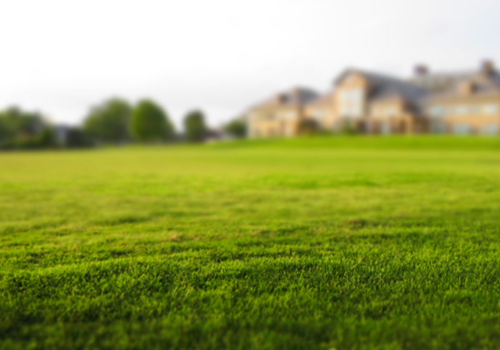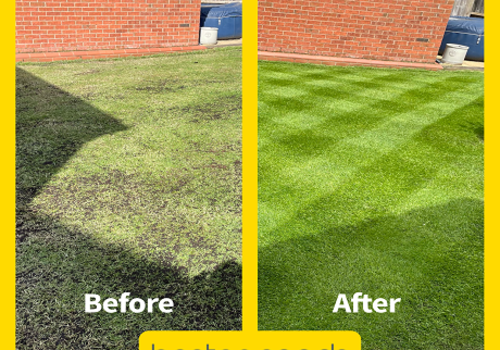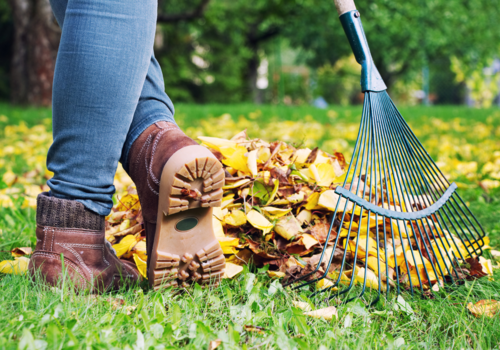
September is a prime month in your lawn care schedule, as the heat of July and August starts to slip away, it’s time to prepare for autumn and winter whilst still keeping on top of growth like you’ve been used to over summer. This month, keep your mower handy but prepare to get your hands dirty with some tasks that will nourish your grass from root to tip.
What should I do to my lawn in September?
Here’s your September lawn care ‘to do’ list:
- Regular mowing
- Autumn fertiliser application
- Aerate compact areas
- Scarify if needed
- Final weed control
- Moss control
- Lawn seeding and renovation
Mowing in September
This month, you’ll still need to cut the grass regularly to keep on top of growth. You can expect to keep mowing around once a week but growth may slow as October nears. At this time, you can mow every couple of weeks. As growth slows down, it’s important to raise the height of your mower blades for a healthy autumn lawn. If you have a moss problem, make sure the grass always remains at least 1” higher than the moss.
From September onwards it’s really important to give your mower a thorough clean every time you cut the grass. Plan to mow in the afternoon if possible, as this will be the driest point in the day at this time of year. This will prevent too many moist grass cuttings building up inside the mower, and make your clean up job a little easier.
Should I fertilise my lawn in September?
Yes, September is a great time of year to fertilise your lawn. The right lawn treatment will aid recovery from summer use and prepare the grass for the harsh conditions of winter. Choose autumn and winter lawn fertiliser to strengthen your grass ready for the winter months ahead.
Dry soil won’t absorb fertiliser, so wait for a good rainfall before feeding. This is more effective than watering yourself, as you run the risk of washing the fertiliser away. You’ll also need to wait until after raking and scarifying to apply your lawn treatment.
Can I scarify my lawn in September?
September is an ideal time of year to scarify your lawn. Raking and scarifying are harsh on your turf though, so only tackle this lawn care task if it really needs doing. If you’ve cared for your lawn well throughout the year, scarifying might not be necessary. So how can you be sure?
Start by checking for thatch, which is a layer of dead turf. Thatch builds up if the rate of grass growth is faster than the rate at which old material dies off. Lawns with a thatch problem will feel spongy to walk on and show a layer of thick, brown debris. More than an inch of thatch can harbour moisture, pests and disease and should be removed.
If this is evident, use a rake or lawn scarifier to gently tease out moss and thatch. This will leave the surface of the lawn quite bare, so fertilise, top dress and overseed to complete the treatment.
Lawn Renovation
After the long summer months, it’s important to consider lawn renovation and repair to prepare for winter. Here’s our lawn care advice for replenishing your lawns to keep them strong, healthy and green into next year.
- Aerating: summer use can leave your lawns compacted, which doesn’t promote good drainage. Reduce compaction with a garden fork, sinking it about 12-15cm deep provides the right amount of aeration. This helps nutrients and moisture circulate for healthier roots.
- Trimming: neaten everything up by trimming the edges of your lawns. Use a spade for straight edges and lawn scissors for more difficult areas.
- Flattening: uneven areas can cause problems in your lawn during winter, so flattening your lawn is a good way to prepare the ground for the coming season. Peaks and troughs can cause areas of drought or flooding so it's important to address them whilst the weather conditions are good. Use a spade to level the ground. Aerate, and then add turf or grass seed.
- Seeding: the soil temperature and moisture levels this month provide ideal conditions for overseeding. If you haven’t already tackled this, you can repair damaged or bare patches in your lawn by sowing some winter hardy grass seed. Sow after a good rainfall and application of preparatory lawn feed.
- Top dressing: after completing all other lawn repair and renovation tasks, you may want to consider top dressing. This is an advanced lawn care task but it can improve soil structure, reduce thatch, smooth the surface of the lawn and encourage root development.
- Keep off the grass: once you have completed all repairs and renovations, it’s best to try not to step on your lawns too much. Use paths or stepping stones as much as possible, and if you don’t have a route through your garden, consider creating one before the end of the autumn.
Moss Control
Moss thrives in colder, wetter conditions so you’ll need to prepare your moss control plan. You can remove moss by scarifying if it’s needed. If necessary, apply a moss killer to treat moss early and avoid a problem in spring.
Laying New Lawns In September
This time of year is ideal for laying new lawns because temperatures and moisture levels support new growth. You can lay fresh turf or use grass seed. Conditions this month are ideal for germination, so consider seeding after mowing, scarifying, and feeding. Make sure there has been a recent fall of rain too, as this will dampen the soil.
It takes around 5-10 days for grass seeds to germinate, so you’ll see growth fairly quickly during early autumn.
Autumn Lawn Care Tips:
- Weeds: it’s best to tackle any remaining weeds before October arrives so consider using a lawn weed killer during September. If you’re already on top of weeds, spot treatments or manual removal might be enough to rid your lawns of weeds before the winter sets in.
- Pests: ants, worms, moles and Leather Jackets can all become pests to the avid lawn care expert in September. It’s best to brush worm casts, ant and mole hills back into the turf to keep an even surface and avoid areas that can harbour weeds and moss. Flatten and level areas if necessary as described above. Leather Jackets are grubs that can feed on the roots of your grass which can cause problems for your grass.
Most gardens do have a number of them at this time of year without them causing too much of a problem. Treatment can be difficult, but application of a lawn pest killer could help to control this problem. The best course of action here is to let nature take its course and focus on repair. Scarify, aerate and overseed once the infestation has passed and you can assess the damage caused.
- Toadstools: as more rain begins to fall and the ground harbours more moisture, you might see toadstools pop up around your lawn. On the whole, these are harmless and will usually disappear quite quickly.
- Disease: this month, problems with dry patch or fairy rings become more apparent. Both these lawn problems are caused by the soil repelling water which leaves dry, brown grass in patches or rings. Dry patches can be treated by spiking and regular watering. Fairy rings however, are caused by a specific type of fungus. You’ll need to treat and control this fungus to stop it dropping spores that will worsen the problem.
As September is such a prime month for lawn renovations you’re well on your way to helping your lawns recover from the warm weather. Putting in the work now will create lush grass for you to enjoy into October and well into the winter months of November and December. Make sure you keep up with our lawn care diary for advice on how to care for your lawns all year round - helping you to make the most of your garden as the seasons change.


